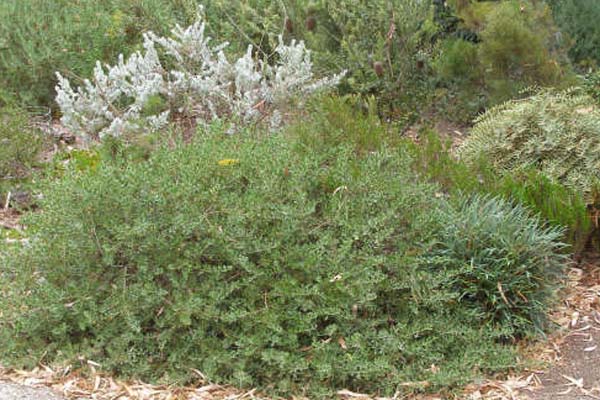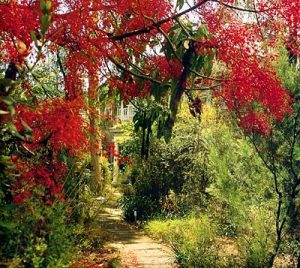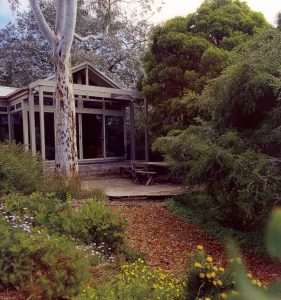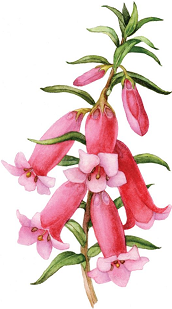Garden Design
Deliberate thought-through approach
Anticipate your future vision and work towards its realisation
No one could argue that it is easy to develop a well-designed garden as so many different concepts have to be kept in mind as you develop your plan; so very many decisions have to be made at the onset before any actual physical work is started.
The success and rewards from most ventures rely on preparation of all sorts. In the case of garden design you need to clarify your ideas to the extent that you can describe or ideally sketch a design on paper, research and cost materials you could use for the hard structure elements to decide which ones you will use and find out as much as possible about a wide range of plants so you can choose ones that will produce the desired effect.
Context
The “borrowed landscape” and a “sense of place”

If you are close to natural bushland the opportunity to make use of the “borrowed landscape” should
influence your design and with due care enable you to make use of what you can see, like tree canopy beyond your own property, to enlarge your sense of space. If you incorporate some of the neighbouring bushland plants into the design of your garden you should also be able to make a seamless transition from bush to home garden, preserving a “sense of place”.
As we live in a primarily European garden environment in urban situations, the opportunity to take advantage of a borrowed Australian plant landscape is more serendipitous. That said, look around to see if there are trees and shrubs growing in neighbouring properties, or on the nature strip, that you could make use of rather than block from view. Try to use local plants in your own garden, including a small eucalypt if possible, to create a “sense of place” and connection to the Australian landscape and to entice native birds and other fauna into your garden.
Photograph: A Borrowed View © Graham Oliver.
Responsibility
The three W’s: weeds, water, wildlife
In working out a garden design there are many things that you can, and probably should, take responsibility for, like the effect on your neighbours of planting large trees right on the common fence-line. There are three things in particular that are worth a special mention:
- Weeds
- Find out which plants in your area are considered to be weeds and avoid using them. Even if your property is not close to bushland weed species can be spread by birds and wind. If you already have weed species growing on your property then remove them at the onset or plan for their staged removal if cost or wildlife concerns dictate otherwise.
- Water
- Accept the level of wet or dry that is your lot due to climate, your garden’s orientation and the drying effects of any large shrubs or trees you wish to retain, and prepare for an even drier future as a result of global warming. You may want to include an idea like the one articulated clearly by John Hunt in his 1986 book “Creating an Australian Garden”, of using mounds and channels to harvest water in seasonally wet times so that it is available to plants throughout the summer months.
- Wildlife
- Think about how you can provide food, shelter and safe, reliable fresh water for visiting animals. If you are a cat lover then consider how you can incorporate a cat enclosure into the design that keeps both your cat and any wildlife safe from danger.
Information, Ideas, Inspiration
You will need all the help you can get
To tackle the task of designing a garden with any confidence you will need all the help you can get.
There are a few relatively recent good publications you can refer to on the topic of garden design specifically in relation to using Australian plants.
“Water-wise Gardening in North East Victoria” – APS Wangaratta
“The Australian Garden: Designing with Australian Plants” – Diana Snape (2002)
“Australian Planting Design” – Paul Thompson (2002)
“The New Native Garden: Designing with Australian Plants” – Paul Urquhart (1999)
These and many other books will provide you with the kind of information you might be looking for on which plants to use.
Australian plant gardens, both public and private, can provide you with ideas. Take the time to visit gardens in Australia’s Open Garden Scheme, visit local public gardens and take advantage of visits organised by APS Victoria.. At the very least the gardens you visit may tell you something about the growth habit of particular plants and you will need to know this to use plants effectively in your design. At their best they will provide you with design ideas and suggest ways of solving design problems. In the case of any good garden you visit, focus less on individual plants and look at what visually works and try to work out how and why a particular feel or effect has been achieved.
Some Australian plant nurseries have developed interesting and informative gardens for the public to look and learn from.
Gardens, apart from Australian plant gardens, can be a source of inspiration and they may help you decide on the style of garden that appeals to you. Take notes or pictures (or cut out pictures from magazines) of what you like so you can analyse how you might achieve something similar using Australian plants.
Draw a Plan
After considering the functions and style of garden that you want, and site constraints, you should be able to describe and ideally sketch, or draw to scale, a design of your garden.
Some of the many things you should consider on your journey towards drawing a final plan of your design are:
- How do you want to use your garden?
- Identify what facilities and features you wish to include; things such as outdoor living areas, children’s play areas, seating, sheds, vegetable gardens, water features and bird baths, sculpture, pathways, areas that need to be screened for privacy and so on.
- What style of garden appeals to you?
- You will need to decide on such things as the level of formality – generally relying on simple geometric shapes for paths and beds- or informality, where garden beds and paths are generally curved. Many different garden styles are discussed by both Snape and Urquhart in books mentioned above.
- How do you want your garden to look?
- You will need to imagine how your garden will look from a number of vantage points and angles. Make sure you consider views into the garden from each window in your home.
- Border gardens
- Border gardens with central lawns are still the norm but it is possible to plan other types of gardens with or without pathways through garden beds. The challenge then is to ensure you preserve a feeling of open space by using groundcovers and small plants, taking care not to crowd beds and particularly paths with too many medium to large shrubs.
- Site constraints
- Slope, orientation, soil type, rainfall and prevailing winds, the visibility of neighbouring properties, existing structures and plants you wish to retain are all design constraints but you are still likely to be left with an enormous choice of ways to realise your plans.
- Materials
- Simultaneously, or possibly subsequently, decisions can be made about which materials to use for the hard and soft (plant) landscape. These things can be written down to form part of the plan. Choose a consistent and limited range of materials for the hard landscaping to unify the design.
- Safety
- Always take safety into consideration when deciding on a design, but most particularly when choosing which materials to use. (For example to build stairs and paths.)
Plant Design
Plants will bring your garden to life, softening the hard landscape, affecting light and shade and changing the perspective of everything as they grow, placing or even nestling, your house into a garden context. One of the real challenges in garden design is being able to imagine how the plants will grow and change your experience of light and space. You start with a description, or ideally a 2D sketch and you must imagine what the 3D effects of the plants will be on what you will see and experience.
Common pitfalls
- Choosing plants that are not an appropriate scale for your garden
In the case of scale the idea is the larger the space you want to fill then the larger the plants you can and should use. If you have a very large garden there may be some areas that are discrete and small and can be populated with small plants, but certainly other areas will need big plants to complement the size of the garden. Clearly the converse is true and great care should be taken not to use too many large shrubs with a bulky appearance in a small garden. - Leaving insufficient space between plants to allow them room to grow
 Leaving insufficient room between plants is due to, for example:
Leaving insufficient room between plants is due to, for example:
- Not using a handy measurement for distance, (like the length of a garden fork).
- Expecting to see something resembling a finished garden at the time you place the plants in the ground (fostered by so many ‘instant garden’ programs)
- The compulsive behaviour of the true plant addict who is more concerned with having a collection than a beautiful garden (more on that later).
There is a place for allowing plants to touch and even sometimes become completely intermingled, but the main argument for allowing room for plants to grow to their full potential is to enable an appreciation of their mature structure, which is why and how you should be using the plant in the first place. So the greater your knowledge of a wide range of plants, their shape, size, growth habits, preferred growing conditions and flowering times the better placed you will be to select appropriate plants for your purpose.
Photograph: Overplanted area – More than ten plants in a few square metres © Tony Cavanagh
Design Functions of Plants
A central aim of garden design is to engender certain responses and feelings that will be most fully realised through the appropriate use of plants.
Trees and perspective

Trees fulfil an important role in garden design providing depth of scale and nestling the house and garden into the site. It is an interesting exercise to walk down the street and imaginatively remove large trees from a nature strip or a garden – immediately the house will appear larger and more exposed. The canopy of even a single tree, (possibly combined with a careful use of larger shrubs to provide a middle-level storey), can provide a sense of being in nature.
Trees are also planted for shade or dappled shade; they provide not only welcome relief from the heat of the sun, but also relief from harsh direct sunlight. Position trees carefully with respect to sun and shade; winter sun will not be blocked if they are placed on the east and west sides of a property.
Trees can help to screen unwanted sights; make sure they are positioned not to hide important views, bearing in mind that in time most of them will develop a trunk, (which may in itself be a very significant and desirable feature of the plant), while allowing through views at ground level.
Remember birds use trees to move from one area to another.
Photograph: Hoffman Walk, Victoria with the white trunks of Eucalyptus scoparia standing above the low, silver-white cushion bush (Leucophyta brownii). © Diana Snape.
Screening and privacy

In most gardens there is a need to screen certain things such as fences, sheds, tanks, service areas, etc for privacy and aesthetic reasons; in doing so select long-lived plants that will grow to an appropriate height for your purpose. Think about whether a view needs to be completely blocked or whether it is sufficient to break up and soften the view. If there is room for a depth of plantings then consider screening at height using trees, with medium and small plants to screen at a lower level. Sight the placement of, say a single plant to hide an electric pole, from the most important viewing point, like the front door.
Be wary of using climbing plants to cover fences as they present certain maintenance issues, can tangle in surrounding plants, are likely to defoliate within a half metre or so of the ground and may invade your neighbour’s property to an unreasonable degree.
Photograph: Acacia cognata ‘Lime Magic’. Dense soft, weeping foliage. For full sun to semi-shade. © Graham Oliver
Open space and light

It is important to preserve a feeling of space in a garden; some hard structure elements of the design, such as paths, paved areas and ponds do just that. Apart from the hard structure there has been a tendency to use lawns to create this feeling. Regardless of whether a lawn is incorporated into your design (and it is possible to do so using Australian grasses) ground-covering plants can be used in lots of ways to create a feeling of space, for example to allow through-views into garden beds, border paths and paved areas, to cascade over rocks, sleeper walls and embankments and to replace the look of a lawn.
The value of using groundcovers and small shrubs is probably best understood by considering the opposite – a garden where paths and courtyards are bordered by medium and large shrubs. Unless you want to create a tall maze, then the use of too many medium and large shrubs will make you feel walled in.
In real ways groundcovers and small plants ‘lighten’ a garden design by letting more light into the garden and stopping the garden becoming oppressive because of too much closed space.
Photograph: Path border of Scaevola albida ‘Super Clusters’. Drought-tolerant ground cover for the water-wise gardener. © Graham Oliver
Vistas

Vistas are those wonderful channelled views down pathways and sometimes through or over garden beds that allow you to see a framed view of what lies beyond. Vistas are one of the most exciting, generally uplifting elements in a garden – they are designed to illicit the “ah!” response.
To create a vista, as opposed to a view, shrubs and/or trees of sufficient height must frame the view.
Vistas may be of distant views or they may be entirely internal to the garden where statues, seats, aspects of the garden and feature plants are the object of interest.
Photograph: Your eye is led to the house by the path and framing by the trees and shrubs.
From “The Australian Garden” by Diana Snape, courtesy Diana Snape. Photo© John Floyd
Peace and excitement

The level to which you will be trying to achieve peace as opposed to excitement will depend quite a bit on your taste in gardens. There is no doubt that much excitement in a garden can come from flowering plants, but rainforest gardens rely more on shades of green and the interesting different textures, forms and growth habits of the plants; they generally of necessity place much less importance on flowers. If choosing to have a garden of flowering plants, then consider using a range of plants that will give seasonal colour over twelve months of the year, which is actually quite easy with Australian plants. Too often people are overly concerned with mix and match of flower colour in their gardens, sometimes not realising that the plants won’t even be flowering at the same time of year!
In design a whole lot of things, like unity and balance, come before excitement, so when making decisions about how to use a particular plant, concentrate on its form and function, growth habit, leaf texture and colour in relation to other plants in the design.
Photograph: Textured and coloured bark of E. pauciflora – (Snow Gum). © Graham Oliver
Unity for harmony

A well designed garden has a unity and therefore a harmony over the whole design, even if parts of the design could be thought of as “garden rooms”. To achieve this with plant design there needs to be some strong elements of repetition. This may be achieved simply by repeating the same plant but in a more complex design. It is also likely to be achieved by repeating the same plant form, the same foliage size and texture, the same colour foliage, or the same flower colour (even from entirely different plants) at a particular time of year. At its most basic level, in a very formal garden, rows of the same plant are used to hedge and strongly define certain lines in the garden.
The less formal garden will be seeking to use repeated visual cues connected throughout the immediate visual distance and even beyond, so that as you walk through the garden it unfolds naturally before your eyes ensuring there is flow and rhythm to movement through the garden.
Photograph: Use of Australian native plants in pots in a small suburban garden. © Graham Oliver
Balance for harmony
You can think about balance in relation to many areas of garden design such as the relative proportions of open space to closed and sun soaked areas to shaded, but primarily the kind of balance that affects whether a garden feels harmonious or not is related to how plants are arranged in space, either symmetrically or asymmetrically, to be aesthetically pleasing. It’s a complex business as in any garden, bar the highly formal, it is not just a matter of balancing the same number of the same size plants on either side of a path. In fact the idea of using odd numbers of any plant, apart from unifying the design, is to allow for different numbers of plants to be used either side of a path; an asymmetrical balance depending on placement.
Balance can be achieved in so many different ways some of which may initially seem odd, like balancing the vertical mass of one plant with the largely horizontal space covered by a low spreading shrub.
Allure
Arguably some of the most interesting gardens, if they are big enough and not just a courtyard garden, capitalise on this idea of allure which is achieved by deliberately not revealing all the beauty of the garden at once. Imagine a path where the plants obstruct your view of what is around the next curve or corner so you want to investigate further. Using this kind of idea is important in stroll gardens or in medium to large gardens although it is also possible to think of your house as helping to keep the secret of what the back garden looks like. In designing the journey from the front into the back garden are you able to set up a sense of anticipation?
Inside views

The design of your garden has a real part to play in producing the feeling that house and garden are an integrated whole. Windows frame the view outside so think carefully about the choice and placement of plants so you enjoy the best views possible into that part of your garden and you can participate in the life of the garden even while largely concerned with life indoors. There are many studies showing that this kind of connection with nature, although quite passive, has real benefits to the occupant of the building.
Safe and secure
Not all feelings of safety are achieved by hard structure alone. If you have paths close to embankments the placement of medium to large shrubs, large clumping plants or “humping” groundcovers will make you feel safe as well as providing necessary perspective. Some plants like banksias have good soil binding root systems that help to stabilise embankments.
Photograph: Snape garden.
From “The Australian Garden” by Diana Snape, courtesy Diana Snape. Photo © Simon Griffths
Tips for Choosing and Using Plants in your Design
- Choose plants suitable for the positions you have
- To match plants to growing conditions you need to know something about seasonal levels of moisture, shifting patterns of sun and shade, prevailing winds, etc throughout your garden. Choose plants suitable for the positions you have – don’t expect to change the conditions you have through introducing soils, sands or making areas reliant on large quantities of water.
- Choose hardy plants
- Choose hardy plants for the particular conditions to build a successful garden; experiment here and there with less reliable plants as that is part of the fun.
- Choose strong healthy plants
- Choose strong healthy plants from nurseries, which does not necessarily mean choosing the largest plant.
- Consider plant’s habit of growth
- You must consider growth habit and not just a plant’s overall dimensions when making a choice between two plants of the same size. A plant’s shape is to some extent determined by its height and width but the growth habit of two shrubs of the same dimensions may be quite different and therefore produce a very different feel; e.g. one plant may have a solid form while another may be soft and weeping.
- “Simplify” look of the garden
- Relate different plants of different sizes with the same foliage type to “simplify” the look of the garden.
- Use contrasting foliage types and colours for interest and accent
- Clumping plants accent other plants
- Clumping plants of different dimensions are a significantly different visual element to other plants and therefore useful as accent plants even if they don’t have showy flowers.
- Flowers are the last consideration
- Remember flowers are in most cases seasonal only, so as a generalisation, they should be a last consideration in choosing one plant over another.
- Choose a wide range of plants
- If your garden is large enough then choose a wide range of plants for interest, different seasonal colour and to support wildlife.
Remember insects are vital to the health of the environment and are a food source for animals such as birds, frogs and lizards.- More small plants
- As a generalisation you will need many more ground-covering and small plants than plants of a larger size.
- Groundcovers are living mulch
- Groundcovers have an important role in shading the ground, preventing excessive moisture loss and suppressing weed growth – they are what we refer to as living mulch.
- Loosen the root ball of pot plants when planting out and cut through any ‘girdling roots’
Plant collectors and garden design
There is no reason why a plant collector cannot also strive to achieve a well designed garden by considering all that has been written above. It means that in using plants from your collection more consideration must be given to their placement in the garden – how they fit into the overall design and relate to the plants around them – rather than the focus being on finding space for them in the garden. And this highlights two different ways of seeing a garden; either to stay focused on individual plants, moving from admiring one individual to the next, or to look up often to take in large views of the garden whilst also admiring individual plants.
An Ordered Approach to Implementing Your Design
There is an orderly approach to implementing any garden design which starts with installing the hard structure elements including and up to contouring and mulching the site. Placing out plants and planting them in the ground is the last task (or joy) of all and so a large amount of discipline is needed to resist the temptation to place plants in the ground any earlier.
Maintaining or making slight changes to your design

Keen gardeners should have no problem in maintaining their garden as they want to garden, they want to be involved in an ongoing dialogue with their gardens.
- Prune plants to preserve shape and improve health, but in time some might need to be removed if they have grown too large for your purpose.
- Replace dead plants in autumn after the rains but not necessarily with the same plant as garden conditions may have changed due to growth of trees and large shrubs. (Disturb the soil as little as possible in summer, bearing in mind that even a dead plant can provide shade and groundcover throughout the hottest months.)
- Replace plant if it is not doing its job after you have given it a reasonable amount of time to grow.
- Allow time for plants to grow – 4 years minimum – and resist the urge to fill in the gaps between plants unless this is a deliberate, temporary gap-filling measure in which case you need to be careful not to disturb the overall design.
- Continue to look at your garden from a design perspective, which means how each part (or plant) relates to the whole, referring back to your original plans.
Photograph: 25 year old Callistemon kept in shape by regular pruning. Photo © Tony Cavanagh.
Don’t be afraid to reassess some aspects of your original design when you see how things work out in reality, as your ideas might change with experience. Read how Tony Cavanagh tackled the challenges of rejuvenating an old garden.
Further Advice
- Garden Design Study Group’s web site
This special interest group operates nationally and has two local groups in Victoria: one in Melbourne and the other in North Eastern Victoria. - Join your local District Group
Membership will enable you to talk about plants and gardens and find out which plants are most likely to succeed in your environment. - Visit bushland areas close to where you live to see what lessons you can learn and adapt from nature.
